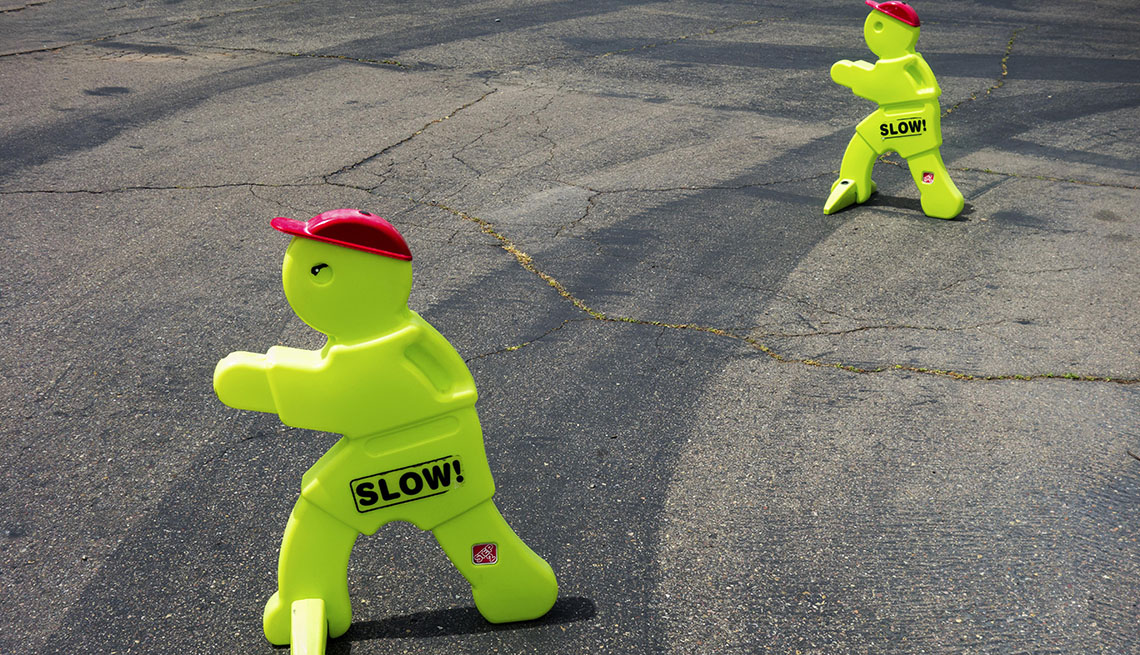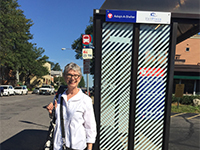11 Vision Zero Solutions
Streets designed for cars are only for cars. Streets designed for drivers, bicyclists and pedestrians are for everyone
1. Reduce the Number of Travel Lanes
Downsizing four-lane roadways to two travel lanes with an alternating turn lane in the middle has become a popular trend across the country. When this "road diet" approach was used on a stretch of Edgewater Boulevard in Orlando, crashes declined 34 percent and injuries 68 percent, while drivers' travel times actually decreased. This explains why the Federal Highway Administration (FHWA) designates road diets as among the Proven Safety Countermeasures it suggests traffic engineers use to reduce collisions at intersections.
2. Reduce the Width of Travel Lanes
Wide lanes invite speeding while narrower lanes send a better message to drivers, says walkable communities expert Mark Fenton, a former member the U.S. national racewalking team.
3. Reduce the Crossing Distance at Intersections
A shorter walk across the street is a safer one. Extending the sidewalk out a few feet into the intersection improves safety for all road users by making pedestrians more visible and slowing the speed of turning traffic.
4. Make Crosswalks More Visible
Mark them with bright swaths of paint or, better yet, elevate them to curb level, which is a technique that has worked in places as varied as downtown San Francisco to rural Harrisonburg, Virginia.
5. Add Medians or Pedestrian Islands in the Middle of Busy Streets
Medians and islands that provide a refuge for people crossing the street have been shown to reduce traffic accidents by 46 percent. The Federal Highway Administration deems this one of its nine Proven Safety Countermeasures.
6. Give Pedestrians a Head Start at Traffic Lights
A three- to seven-second head start allows pedestrians to enter the crosswalk first, making them more visible to motorists. This results in up to 60 percent fewer pedestrian-vehicle collisions, according to the National Association of City Transportation Officials.
7. Ban Right Turns on Red at Busy Intersections
Drivers, stopped at the red light and busy watching out for other cars, often don’t see people crossing the street on green lights. Best option: Prohibit them at high-traffic intersections and streets. For instance, right turns on red are not allowed in New York City.
8. Install Traffic Calming Measures
Roundabouts, speed humps and other traffic calming solutions remind motorists to drive slower and keep an eye out for people on foot. Roundabouts (another FHWA safety countermeasure) added to La Jolla Boulevard in San Diego led to more people walking, the creation of new businesses, more on-street parking and shorter travel times for motorists.
9. Convert One-Way Streets to Two-Way
Two way streets encourage safer, slower driving and less noise for local residents. Tampa, Dallas, Louisville and San Jose are among the cities changing streets back to two-way.
10. Install Red Light Cameras
It's expensive to station a police car at every unsafe intersection, but cameras can nab lawbreakers who speed, run red lights or don’t yield to people walking. More than 550 communities from Sacramento to Charlotte now use red light cameras.
11. Create and Enforce Stricter Traffic Laws
Killing or injuring people with a car is no less tragic than doing it with a weapon. Seattle won top honors as a Walk Friendly Community, in part, for its Aggressive Driver Response Team where neighborhoods work with police to curb dangerous drivers.
"These pedestrian improvements typically improve motorists' and bicyclists' safety," says Charlie Zegeer, director of the Pedestrian and Bicycle Information Center at the University of North Carolina. "It's a win-win-win. Everyone's safer."
Jay Walljasper is a writer, speaker and consultant on making our communities great places for everyone and author of The Great Neighborhood Book. He is the urban writer in residence at Augsburg College in Minneapolis and a senior fellow at Project for Public Spaces. Contact him at JayWalljasper.com.
Stay Informed — For Free!
AARP.org/Livable
Enter a topic, name, place, etc.







